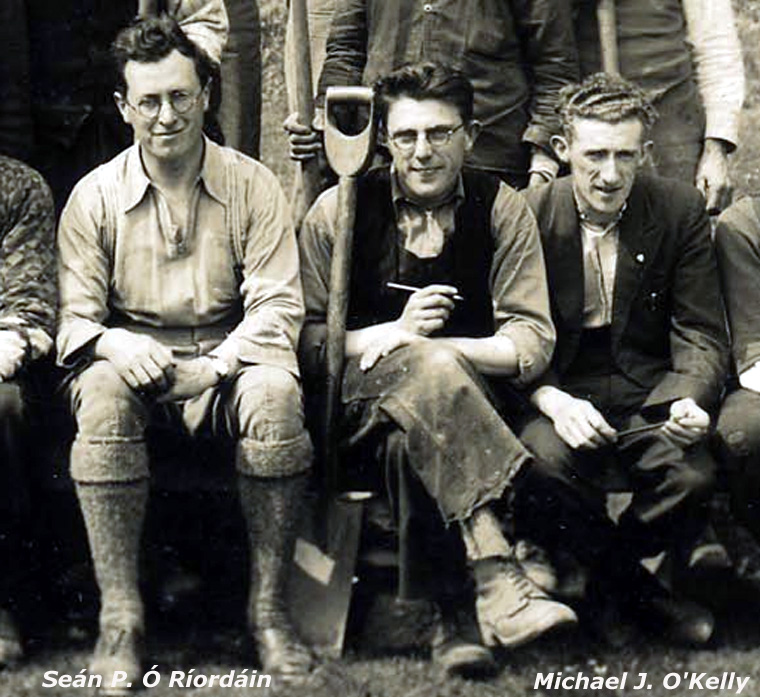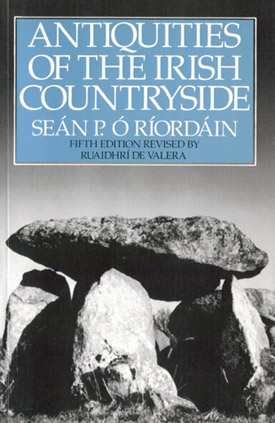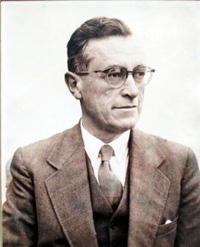Seán P Ó Ríordáin (1904–1957)

Seán P. Ó Ríordáin and Michael J. O'Kelly at the Lough Gur excavation in 1937
Seán Pádraig Ó Ríordáin was a pioneering archaeologist known for his significant contributions to Irish archaeology. Initially trained as a teacher, he later pursued advanced studies in archaeology, earning his MA and Ph.D. Ó Ríordáin conducted extensive fieldwork, notably at Lough Gur in Co. Limerick, where he excavated for eighteen years, shedding light on its multi-period history.
He also investigated Ireland's Roman archaeology, contributed to the understanding of early medieval history, and initiated important work on the passage graves at Newgrange. Notably, he conducted groundbreaking research at Tara in Co. Meath, making significant discoveries, including an undisturbed passage grave.
His work extended beyond excavations; he published extensively, authored major works like Antiquities of the Irish Countryside, and revitalized archaeological societies. Ó Ríordáin's legacy lies in his transformative impact on Irish archaeology, introducing modern techniques and inspiring a new generation of scholars.
 Antiquities of the Irish Countryside by Seán P. Ó Ríordáin.
First Published in 1942, Fifth Edition revised by Ruaidhrí de Valera in 1979.
Antiquities of the Irish Countryside by Seán P. Ó Ríordáin.
First Published in 1942, Fifth Edition revised by Ruaidhrí de Valera in 1979.
From the preface to the First Edition (Cork University Press, 1942)
This booklet is not intended for specialists in archaeology. Its purpose is to give some answer to the questioning man in the street, who asks the archaeologist for a simple explanation of some monument which he has noticed in the countryside and which is, in all probability, a typical example of a class of antiquity widespread throughout Ireland.
The question usually concerns an individual structure, be it fort, souterrain, stone circle, or other antiquity, of which the archaeologist, lacking evidence which excavation might yield, can say little. He can, however, explain at some length what is known of this type of monument.
Purchase at Amazon.com or Amazon.co.uk
Seán P. Ó Ríordáin - Irish Archaeologist
 Seán
Pádraig Ó Ríordáin was an Irish Archaeologist, born on 17 December 1904 in Monkstown, Cork.
Initially apprenticed in the Cork dockyard, Ó Ríordáin studied at night for Department of Education
examinations, which he successfully passed, and he became a national school teacher.
Seán
Pádraig Ó Ríordáin was an Irish Archaeologist, born on 17 December 1904 in Monkstown, Cork.
Initially apprenticed in the Cork dockyard, Ó Ríordáin studied at night for Department of Education
examinations, which he successfully passed, and he became a national school teacher.
He continued to study at night and graduated with a BA (1928) from UCC. He was greatly interested in the Irish language and culture and developed a lifelong enthusiasm for archaeology. Taking his MA with first-class honors (1930), he went on to win the NUI traveling studentship (1931). This provided him with an opportunity to study archaeological field techniques and museum collections in Britain and on the Continent.
During this time, at the suggestion of Professor R.A.S. Macalister and Dr. Adolf Mahr, he began to study halberds, a type of artifact typical of the Bronze Age; for this work, he was awarded a Ph.D. by the NUI.
After his period of travel, Ó Ríordáin joined the Irish antiquities division of the National Museum in Dublin. In 1936 he succeeded Canon Patrick Power as professor of archaeology at UCC. In 1943, after the death of Macalister, Ó Ríordáin was appointed to the chair of Celtic archaeology at UCD. Both departments with which he was involved developed new areas of research expertise and were particularly active in teaching; the UCD department was transformed by Ó Ríordáin's work, according to Michael J. O'Kelly.
Ó Ríordáin introduced a new generation of Irish archaeologists, including O'Kelly, Etienne Rynne, and Ruaidhrí de Valera, to the modern techniques of field archaeology in which he had been trained during his studentship.
Ó Ríordáin was noted for his fieldwork, especially for his eighteen years of excavations carried out at the multi-period site of Lough Gur, Co. Limerick, which elucidated much of its complex history and formed the basis for still-continuing study. He also analyzed Ireland's Roman archaeology, contributed considerably to knowledge of Ireland's early medieval history, and initiated important work on the passage graves at Newgrange; his co-author, the Cambridge archaeologist Glyn E. Daniel, published their study of these sites in 1964, after Ó Ríordáin's death.
Ó Ríordáin began digging on the Hill of Tara in Co. Meath in 1955; his preliminary work on this hugely significant site was the first modern investigation, and even though it remained unpublished for many years is recognized by contemporary archaeologists as being of lasting relevance. Major discoveries, including an undisturbed passage grave on the site, were announced at the time in newspapers. Ó Ríordáin gave frequent public lectures and talks on the radio; he was one of the first archaeologists from Ireland to appear on British television, featuring the reconstruction of ancient dwellings at Lough Gur. He also appeared on the panel program ‘Animal, Vegetable, Mineral,’ chaired by Glyn Daniel.
He published numerous papers and excavation reports in various archaeological journals, and his major book Antiquities of the Irish countryside (1942), which has been republished in five editions, provides undergraduates and the general public of the twenty-first century with an unrivaled introduction to Irish field monuments. While he was in Cork, Ó Ríordáin revitalized the long-established Cork Historical and Archaeological Society as its honorary secretary and editor of its journal. Its membership almost doubled, and the enlarged and redesigned journal enjoyed a much wider readership outside Ireland. He was given an honorary life membership of the Society. Ó Ríordáin's address as president of the Royal Society of Antiquaries of Ireland was published in the Society's 1955 journal; it was an important critical assessment of the current state of Irish archaeology. He was president 1953–6. He was awarded a D.Litt. by the NUI and was elected MRIA (1936).
Ó Ríordáin married in 1936; his wife was the sculptor and painter Gabriel Hayes. They had one son and one daughter. Ó Ríordáin became ill in the autumn of 1956 and died on 11 April 1957 in Dublin, at the age of 52.
Boyne Valley Private Day Tour
 Immerse yourself in the rich heritage and culture of the Boyne Valley with our full-day private tours.
Visit Newgrange World Heritage site, explore the Hill of Slane, where Saint Patrick famously lit the Paschal fire.
Discover the Hill of Tara, the ancient seat of power for the High Kings of Ireland.
Book Now
Immerse yourself in the rich heritage and culture of the Boyne Valley with our full-day private tours.
Visit Newgrange World Heritage site, explore the Hill of Slane, where Saint Patrick famously lit the Paschal fire.
Discover the Hill of Tara, the ancient seat of power for the High Kings of Ireland.
Book Now
Home
| Visitor Centre
| Tours
| Winter Solstice
| Solstice Lottery
| Images
| Local Area
| News
| Knowth
| Dowth
| Articles
| Art
| Books
| Directions
| Accommodation
| Contact
